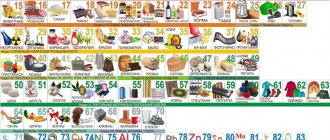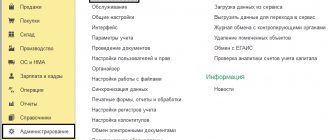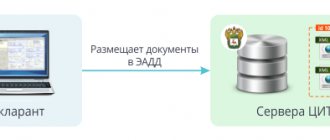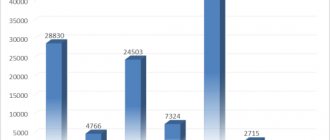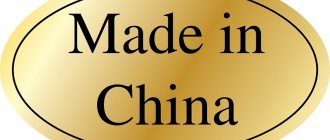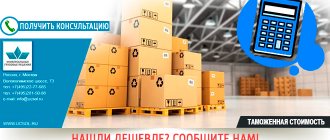Kontur.Accounting is a web service for small businesses!
Quick establishment of primary accounts, automatic tax calculation, online reporting, electronic document management, free updates and technical support.
Try it
Import and export operations of goods always go through customs. To classify cargo and calculate customs duties, a special nomenclature has been developed - the EAEU Commodity Nomenclature for Foreign Economic Activity. In this article we will understand what the HS code is and how to apply it.
What is the Commodity Nomenclature for Foreign Economic Activity and why is it needed?
Keep records of exports and imports using the simplified tax system in the Kontur.Accounting web service. Currency accounting and work instructions, taxes, automatic salary calculation and reporting in one service Get free access for 14 days
Commodity Nomenclature of Foreign Economic Activity is a commodity nomenclature for foreign economic activity of the Eurasian Economic Union. This is a coded type of cargo transported through customs. First of all, it is needed by the customs service and helps to calculate duties when crossing the border and determine what certificates and licenses are needed for transportation.
It is important to correctly determine the HS code. If you determine the code yourself, it will be checked by a customs officer. He may not agree with the choice of code, then the customs clearance procedure will be delayed. There will be additional costs for storing goods in a temporary warehouse. If you are in doubt about choosing a code, contact a specialist. There are many companies on the market that will provide you with services not only in choosing the product range of foreign trade activities, but also in full support of foreign trade activities.
Current problems of identification and classification of goods using the example of the 44th group of the EAEU Commodity Nomenclature for Foreign Economic Activity
This article analyzes the materials of judicial practice on the identification and classification of goods of group 44 by the Commodity Nomenclature of Foreign Economic Activity of the Eurasian Economic Union. Based on the results of the study, the main problems of identification and classification were identified.
Key words: Commodity Nomenclature for Foreign Economic Activity of the EAEU, notes, explanations, disputed goods, heading, customs examination.
The topic of classification of goods in accordance with the Commodity Nomenclature of Foreign Economic Activity (TN FEA) [1] is one of the most relevant for participants in foreign economic activity. Firstly, the classification of a product to one or another classification code of the Commodity Nomenclature of Foreign Economic Activity of the EAEU often requires special knowledge and examinations related to determining the characteristics of goods, such as source material, production method, purpose, etc. Secondly, from The rate of duty and VAT and, accordingly, the amount of customs duties paid depend on which classification code of the Commodity Classification of Foreign Economic Activity the goods will be assigned to. Naturally, most disputes with customs authorities arise precisely at the stage of confirming the classification code of the goods declared by the declarant. Problems arise due to unreliable information about the product, incompleteness of the specified information, or incorrect application of the Basic Rules for the Interpretation of the Commodity Nomenclature of Foreign Economic Activity. Thus, one of the main tasks of customs authorities is to prevent false declarations, since the amount of customs duties and the application of non-tariff regulation measures depend on the declared code.
During the study, an analysis of judicial practice materials was carried out [5] using the example of goods of group 44 of the EAEU Commodity Nomenclature for Foreign Economic Activity (Table 1).
Table 1
Signs of identification of wood products
| Signs of comparison | Declarant: JSC "UNITRADE" | Customs |
| Description 31 columns of the Declaration of Goods: particle boards made of wood with a surface covered with paper impregnated with melamine: Werzalit chipboards. Manufacturer: GENTAS GENERAL METAL SANAYI VE TI-CARET AS, trademark: Gentas | ||
| Classification code of the Commodity Nomenclature of Foreign Economic Activity of the EAEU | 4410 11 300 0 | 9403 90 300 0 |
| Texts of product items | Particle board, oriented strand board (OSB) and similar board (for example, wafer board) of wood or other lignified materials, not impregnated or impregnated with resins or other organic binders | Other furniture and parts thereof |
| Product type | particle boards made of wood with a surface covered with paper impregnated with melamine | furniture parts (table top) |
| Raw material | Chipboard | Chipboard |
| Purpose | basis for processing for further use as tabletops, window sills, floor, wall or ceiling coverings, as well as for use in various areas. | for use as part of furniture for its further assembly |
| Treatment | the surface, edge and ends of the slabs are processed by rounding | rounded corners, a side with an adjacent groove, a chamfer on the bottom side of the ends, on the reverse side of tabletops of square and rectangular shapes there are blind technological holes for attaching the tabletops to the furniture body, there are no untreated surfaces |
| Finishing | paper impregnated with melamine on the front surface | covered on the front and back sides with a polymer material based on melamine-formaldehyde resin (customs expert’s conclusion) |
| Duty amount | 5% and VAT - 18% | 0.5 euros per kg and VAT - 18% |
In column 31 of the declaration of goods [4], the declarant indicated: “particle boards made of wood with a surface covered with paper impregnated with melamine: Werzalit chipboards. Manufacturer: GENTAS GENERAL METAL SANAYI VE TI-CARET AS, trademark: Gentas.”
The declarant believes that, since the presented goods do not have technological holes and grooves for fasteners, then, based on the notes to group 44 of the EAEU CN FEA and explanations to the heading 4410 of the EAEU CN FEA (this heading includes goods that do not have the property parts of products), the goods must be classified in subheading 4410 11 300 0.
According to information from the manufacturer of the goods [6], particle boards made from Werzalit wood are the basis for processing to specific customer orders for further use as countertops, window sills, floor, wall or ceiling coverings, for laying out mosaics on the verandas of garden plots or as a design decoration for premises, etc.
However, within the framework of the risk management system for the goods, a decision was made to appoint a customs examination and samples were taken.
According to the conclusion of the customs examination of the Smolensk Customs [6], the declared goods are parts of furniture (table tops) of round, square and rectangular shapes, made of particle boards coated on the front and back sides with a polymer material based on melamine-formaldehyde resin. Based on the conclusion of the customs expert, code 9403 90 300 0 was declared.
Description of the product during the examination - tabletops (the upper flat part of the table), subjected to additional processing, have rounded corners, a collar with an adjacent groove, a chamfer on the underside of the ends, on the reverse side of tabletops of square and rectangular shapes (except for rectangular shapes, size 60x110 cm) , there are blind technological holes for attaching tabletops to the furniture body, there are no untreated surfaces.
The declarant believes that the presence of blind holes in a number of chipboards located on the reverse side is a mandatory operation of the technological process, which makes it possible to further process these holes for fastening according to a given template or use individual holes based on the purpose of the boards.
Thus, the presence of non-through holes in particle boards in the disputed product does not indicate that this product acquires the properties of products or parts of products. This means that the customs authority had no grounds for classifying the goods in question according to commodity subposition 9403 90 300 0 TN FEA.
The description of heading 4410 of the EAEU CN FEA [1] states “Particle boards, oriented strand boards (OSB) and similar boards (for example, wafer boards) of wood or other lignified materials, not impregnated or impregnated with resins or other organic binders” .
According to the Explanations [2] to commodity item 4410 of the EAEU Commodity Nomenclature for Foreign Economic Activity, particle board is a flat product of various lengths, widths and thicknesses, manufactured by pressing or extrusion.
Articles of this heading fall within this heading whether or not they have been worked; they may be curved, corrugated, perforated, cut or formed into a shape other than square or rectangular, and whether or not their surface has been , edge or end is worked, or lined, or covered (for example, with textile material, plastic, paint, paper or metal), or subjected to any other operation, provided that these operations do not impart to it the essential property of articles of other headings.
Note 4 to Chapter 44 states that articles of heading 44.10, 44.11 or 44.12 may be given the profile characteristic of articles of heading 44.09 and may be curved, corrugated, perforated, cut or formed into a shape other than square or rectangular, or subjected to any other processing, provided that this does not impart to them the properties of products of other headings.
Hypothetically, the product in question could be included in heading 4409, since it was revealed that it had a chamfer, that is, a surface formed by a bevel of the end edge of the material; grooves and collar (protrusion on the supporting part), which makes it possible to classify it as a profiled molding, products with ridges, grooves, tongue-and-groove, with hewn edges, with a connection in the form of a semicircular groove, shaped, rounded or similar. But during the examination, the samples were also found to have non-through technological holes for attaching tabletops to the furniture body, which excludes the possibility of classifying it in the above-mentioned heading.
Thus, the identified surface treatment indicates that the presented product acquires the properties of product parts.
In accordance with clause 178 of the order of the Federal Customs Service of Russia dated August 15, 2014 No. 233-r “On the classification of individual goods according to the Commodity Nomenclature of Foreign Economic Activity of the Customs Union” [5], furniture supplied disassembled, in accordance with the OPI Commodity Nomenclature of Foreign Economic Activity 2(a) is classified in positions , intended for classification of finished products. If the kit does not contain parts that provide the furniture with basic features and functionality, the components should be classified as furniture parts.
According to the Explanatory Note [3] to Chapter 94: This Chapter covers only the worked and unworked parts of articles falling in headings 94.01 to 94.03 and 94.05 if they can be identified by shape and other characteristic features as parts intended solely or principally for the article included in any of these headings.
The fact that the product in question does not have through holes is irrelevant, since the representative did not refute the customs argument that the product does not require mandatory additional modification, and did not indicate what specific additional modification the product must undergo to perform the function of the finished product (or composition of the finished product). In addition, the disputed product has markings for drilling holes and fastening fittings and other parts of furniture.
Based on the foregoing, the court rightly indicated that the disputed goods have a finished appearance and, taking into account its qualitative and quantitative parameters, are not particle boards, but are finished products - parts of furniture (countertops), therefore, in accordance with Rules 1, 2 (a) and 6 OPI of the Commodity Nomenclature of Foreign Economic Activity of the EAEU, the goods are reasonably classified by customs authorities in the commodity subposition 9403 90 300 0 of the Commodity Nomenclature of Foreign Economic Activity of the EAEU.
Literature:
- Unified Commodity Nomenclature for Foreign Economic Activity of the Eurasian Economic Union (TN FEA EAEU) (as amended on March 16, 2020) “On approval of the Unified Commodity Nomenclature for Foreign Economic Activity of the Eurasian Economic Union and the Unified Customs Tariff of the Eurasian Economic Union” (with amendments and additions, entry. in force from 05/04/2020) // URL: https://www.consultant.ru
- Explanations to the Unified Commodity Nomenclature of Foreign Economic Activity of the Eurasian Economic Union (TN FEA EAEU) (Volume III. Sections IX - XIII. Groups 44–70) // URL: https://www.consultant.ru
- Explanations to the Unified Commodity Nomenclature of Foreign Economic Activity of the Eurasian Economic Union (TN FEA EAEU) (Volume V. Sections XVI - XXI. Groups 85–97) // URL: https://www.consultant.ru
- Decision of the Customs Union Commission dated May 20, 2010 N 257 (as amended on December 17, 2019) “On the form of the declaration for goods and the procedure for filling it out” (together with the “Procedure for filling out the declaration for goods”) // URL: https://www. consultant.ru
- Order of the Federal Customs Service of Russia dated August 15, 2014 No. 233-r “On the classification of individual goods according to the Commodity Nomenclature of Foreign Economic Activity of the Customs Union” https://www.consultant.ru
- Archive of decisions of arbitration courts // URL: https://ras.arbitr.ru
Structure of the Commodity Nomenclature of Foreign Economic Activity
The code consists of 10 digits, each of them means something. Let's look at the structure of the product range with examples.
First two digits . Designate a product group. There are 97 groups in total, which are combined into 21 sections. For example, code 50 is a group of silk included in section 11 - textile materials.
The first four digits. Expand the product group to a product item. For example, 50 - silk, adding two more digits 07, we get code 5007 - fabrics made from silk threads or from silk waste.
The first six digits reveal the product subitem. For example, code 500720 - silk fabrics with 85% silk thread content.
Ten digits - the code that is indicated in the customs declaration. This is the encoded name of a specific product. Code 5007204100 - translucent (lace) silk fabrics with 85% silk thread content.
Eurasian Economic Commission
BASIC RULES FOR INTERPRETING HS HS
Classification of goods in the Commodity Nomenclature of Foreign Economic Activity (TN FEA) is carried out according to the following Rules:
1. The names of sections, groups and subgroups are given only for ease of use of the Commodity Nomenclature of Foreign Economic Activity; for legal purposes, the classification of goods in the Commodity Nomenclature of Foreign Economic Activity is carried out based on the texts of commodity items and the corresponding notes to sections or groups and, unless otherwise provided by such texts, in accordance with the following provisions:
2. a) Any reference in the title of a heading to any product shall also be considered as a reference to such product in an incomplete or unfinished form, provided that, being presented in an incomplete or unfinished form, this product has the essential property of a complete or completed product , and shall also be construed as a reference to a complete or complete good (or classified in the heading in question as complete or complete by virtue of this Rule), presented unassembled or disassembled.
b) Any reference in the heading to any material or substance shall also be construed as a reference to mixtures or combinations of that material or substance with other materials or substances. Any reference to a product made of a particular material or substance shall be construed as a reference to goods consisting wholly or partly of that material or substance. Classification of goods consisting of more than one material or substance is carried out in accordance with the provisions of Rule 3.
3. If, by virtue of Rule 2(b) or for any other reason, there is, prima facie
, the possibility of classifying goods into two or more product positions, the classification of such goods is carried out as follows:
a) Preference is given to the product item that contains the most specific description of the product, compared to product items with a more general description. However, when each of two or more headings relates only to part of the materials or substances included in the composition of a mixture or multicomponent article, or only to part of the goods presented in a set for retail sale, then these headings should be considered equivalent in relation to that product, even if one of them gives a more complete or accurate description of the product.
b) Mixtures, multi-component articles consisting of different materials or made from different components, and goods presented in sets for retail sale, the classification of which cannot be made in accordance with the provisions of Rule 3(a), shall be classified according to that material or component. parts that give the goods an essential property, provided that this criterion is applicable.
c) Goods which cannot be classified in accordance with the provisions of Rule 3(a) or 3(b) shall be classified in the heading last in ascending order of codes among the headings equally eligible for consideration in the classification of those goods. .
4. Goods, the classification of which cannot be carried out in accordance with the provisions of the above Rules, are classified in the heading corresponding to the goods that are most similar (close) to the goods in question.
5. In addition to the above provisions, the following Rules shall apply to the following goods:
a) Cases and cases for cameras, musical instruments, guns, drawing supplies, necklaces, as well as similar containers, specially shaped or adapted to accommodate the corresponding product or set of products, suitable for long-term use and presented together with the products for which it is intended , must be classified together with the products packaged in them, if this type of container is usually sold together with these products. However, this Rule does not apply to containers, which, forming a single whole with the packaged product, give the latter its main property.
b) Subject to the provisions of Rule 5(a) above, packaging materials and containers supplied with the goods they contain shall be classified together if they are of the kind normally used for packaging those goods. However, this provision is not mandatory if such packaging materials or containers are clearly suitable for reuse.
6. For legal purposes, the classification of goods in subheadings of a heading must be carried out in accordance with the names of the subheadings and the notes related to the subheadings, and also, mutatis mutandis
, the provisions of the above Rules, provided that only subpositions at the same level are comparable. For purposes of this Rule, appropriate section and chapter notes may also apply unless the context otherwise requires.
ABBREVIATIONS AND SYMBOLS
| BIS | large integrated circuit |
| Bk | becquerel |
| IN | volt |
| W | watt |
| Hz | hertz |
| GHz | gigahertz |
| dtex | an off-system unit of linear density of fibers or threads, equal to the ratio of their mass to length. 1 dtex = 10 mg/m |
| IR | infrared |
| TO | kelvin |
| kVA | kilovolt-ampere |
| kW | kilowatt |
| kHz | kHz |
| kgf | kilogram-force |
| km | kilometer |
| kN | kilonewton |
| kPa | kilopascal |
| kcal | kilocalorie |
| wt.% | percentage content by weight |
| Mbit | 1,048,576 bits |
| MHz | megahertz |
| m- | meta- |
| mg | milligram |
| mm | millimeter |
| µCi | microcurie |
| mN | millinewton |
| N | newton |
| about.% | content percentage by volume |
| O- | ortho- |
| P- | pair- |
| With | second |
| sg | centigram |
| cm | centimeter |
| cm2 | square centimeter |
| cm3 | cubic centimeter |
| cN | centinewton |
| cm/sec | centimeter(s) per second |
| °C | degrees Celsius |
| ASTM | American Society for Testing and Materials |
| INN | International Nonproprietary Name |
| INNM | International Nonproprietary Name Modified |
| ISO | International Organization for Standardization, International Organization for Standardization |
| + | the specified digital code was used in the previous edition of the HS, but had a different coverage of goods |
UNITS OF MEASUREMENT USED IN HS
| Unit name | Symbol | Unit codes |
| BASIC UNIT | ||
| Kilogram | kg | 166 |
| ADDITIONAL UNITS OF MEASUREMENT | ||
| Gram | G | 163 |
| Gram of fissile isotopes | g D/I | 306 |
| Load capacity in tons | t grp | 185 |
| Square meter | m2 | 055 |
| Kilogram of nitrogen | kg N | 861 |
| Kilogram of potassium hydroxide | kg KOH | 859 |
| Kilogram of sodium hydroxide | kg NaOH | 863 |
| Kilogram of potassium oxide | kg K2O | 852 |
| Kilogram of hydrogen peroxide | kg H2O2 | 841 |
| Kilogram of phosphorus pentoxide | kg P2O5 | 865 |
| Kilogram of 90% dry matter | kg 90% dry | 845 |
| Kilogram of uranium | kg U | 867 |
| Cubic meter | m3 | 113 |
| Curie | CI | 305 |
| Liter | l | 112 |
| Liter of pure (100%) alcohol | l 100% alcohol | 831 |
| Meter | m | 006 |
| Metric carat (1 carat = 2 10-4 kg) | car | 162 |
| Pair | steam | 715 |
| One hundred pieces | 100 pieces | 797 |
| A thousand pieces | 1000 pcs | 798 |
| Thing | PC | 796 |
| 1000 kilowatt hour | 1000 kWh | 246 |
| 1000 cubic meters | 1000 m3 | 114 |
| 1000 liters | 1000 l | 130 |
Algorithm for determining the code
Keep records of exports and imports using the simplified tax system in the Kontur.Accounting web service. Currency accounting and work instructions, taxes, automatic salary calculation and reporting in one service Get free access for 14 days
Let's look at the algorithm for choosing a code for the Commodity Nomenclature of Foreign Economic Activity using an example. We are going to purchase carpets from a foreign partner. The carpets are not simple, but knotted, made of wool containing more than 10% silk threads. How did we know this? Requested information and documents from the supplier.
We start by finding a group. Carpets are made from textile materials. So we select section 11 “Textile materials and products”. Code 57 is ideal in this section - carpets and other textile floor coverings. Next we look at the product position. Our carpets are knotted, which means code 57 01. Subposition code 57 01 10 - wool carpets. Since our carpet contains silk, the HS code is 57 01 10 1000.
The difficulty arises when choosing the last four digits. You need to have all the documentation for the product in order to correctly determine the code. For example, if the carpets contained not 10% silk, but 8%, then the code would be 57 01 10 9000.
From the code we find out that the import duty is 0.38 euros per sq.m. There is no export duty. Carpets are not subject to excise tax, VAT is 20%. No licenses are needed for export and import. We need sanitary and epidemiological control at the border. When importing carpets, you need a CT-1 certificate to confirm the country of origin of the cargo.
In some cases, difficulties arise in the classification of goods, for example, when the same product can be classified into two or more product items (for example, by materials and functions). In these cases, for the purpose of unambiguous classification of goods in the Commodity Nomenclature of Foreign Economic Activity of the EAEU, built on the basis of the Harmonized System for Description and Coding of Goods, the classification uses the basic rules for interpreting the Commodity Nomenclature of Foreign Economic Activity.
The basic rules for interpreting the Commodity Nomenclature of Foreign Economic Activity allow the principle of unambiguous classification of goods into certain commodity items and subitems to be strictly observed.
At the same time, to correctly determine the classification code of a product in accordance with the EAEU HS, the following is necessary:
- exact name and characteristics of the product;
- knowledge of classifier construction.
The basic rules for interpreting the Commodity Nomenclature of Foreign Economic Activity are numbered from 1 to 6, however, some rules have divisions within themselves, so rule 2 is divided into rules 2 (a) and 2 (b), rule 3 - into rules 3 (a), 3 (b) and 3 (c), rule 5 - to rules 5 (a) and 5 (b).
The basic rules for interpreting the Commodity Nomenclature of Foreign Economic Activity formulate the main principles of classification of goods, where the first five rules are intended to establish a commodity item, and the last (sixth) is to determine subitem and sub-item.
Before turning to the basic rules of interpretation of 2, 3, 4, 5 and 6 of the TN FEA, it is necessary to study the notes to certain sections and groups (this is indicated by rule 1 of the TN FEA).
If using Rule 1 of the Commodity Nomenclature for Foreign Economic Activity it was not possible to determine the commodity item, then you must remember the following:
- rules 2 and 5 of the CN FEA can be used only after applying rule 1 of the CN FEA;
- for heterogeneous goods, rules 2 (b), 3 (a), 3 (b), 3 (c) of the Commodity Classification of Foreign Economic Activity are applied consistently;
- Rule 4 of the Commodity Nomenclature of Foreign Economic Activity is applied only after it is impossible to apply rules 1-3 of the Commodity Nomenclature of Foreign Economic Activity;
- rules 2 (b), 5 (a), 5 (b) of the HS can be applied in any order, and even with each other simultaneously (for example, a disassembled children's bicycle in a cardboard box must be classified according to rules 2b and 5b);
- Rule 5(b) applies only if Rule 5(a) cannot be applied.
After the corresponding commodity item has been determined, at each next level of determining the classification code (commodity subitem and sub-item), rule 6 of the Commodity Nomenclature of Foreign Economic Activity is applied, and, if necessary, on the basis of this rule, interpretation rules of the Commodity Nomenclature of Foreign Economic Activity from 1 to 5 can be applied.
Rule 1
Rule 2
Rule 3
Rule 4
Rule 5
Rule 6
Additional material on the topic in the section Commodity nomenclature of foreign economic activity
